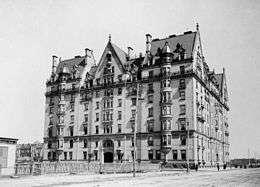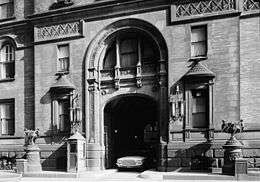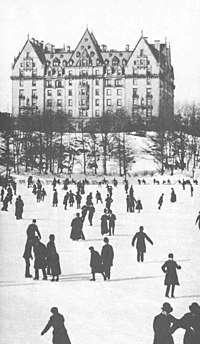The Dakota
The Dakota, also known as the Dakota Apartments, is a cooperative apartment building located on the northwest corner of 72nd Street and Central Park West in the Upper West Side of the borough of Manhattan in New York City, United States. Its construction was completed in 1884. The Dakota was the home of John Lennon, a former member of the Beatles, from 1973 until his murder in the archway of the building in 1980.
The Dakota | |
New York City Landmark
| |
.jpg) As seen from Central Park West | |
   | |
| Location | 1 West 72nd Street Manhattan, New York City, NY 10023 United States |
|---|---|
| Coordinates | |
| Built | 1881 |
| Architect | Henry Janeway Hardenbergh |
| Architectural style | Renaissance Revival, English Victorian |
| NRHP reference No. | 72000869 |
| Significant dates | |
| Added to NRHP | April 26, 1972[1] |
| Designated NHL | December 8, 1976[2] |
| Designated NYCL | February 11, 1969 |
History
The Dakota was constructed between October 25, 1880, and October 27, 1884.[3] Henry Janeway Hardenbergh's architectural firm was commissioned to create the design for Edward Cabot Clark, head of the Singer Manufacturing Company. The building purportedly was named The Dakota because at the time of its construction, the area was sparsely inhabited and considered remote from the inhabited area of Manhattan, just as the Dakota Territory was considered remote. The earliest appearance of this story, however, was in a 1933 newspaper interview with The Dakota's long-time manager. Christopher Gray's book New York Streetscapes quotes the interaction thus: "Probably it was called 'Dakota' because it was so far west and so far north". Gray believed that the building's name stemmed from Clark's fondness for the names of the new western states and territories.[4]
The Dakota was designated a New York City Landmark in 1969.[5] The building was added to the National Register of Historic Places in 1972,[1] and was designated as a National Historic Landmark in 1976.[2][6]
Features


The building's high gables and deep roofs with a profusion of dormers, terracotta spandrels and panels, niches, balconies, and balustrades give it a German Renaissance character and an echo of a Hanseatic town hall. Its layout and floor plan, however, were strongly influenced by French architectural trends in housing design that had become known in New York City in the 1870s. High above the 72nd Street entrance sits the face of a Dakota Indian.[8][9]
The Dakota is a square building built around a central courtyard. The arched main entrance is a porte-cochère large enough for the horse-drawn carriages that once entered and allowed passengers to disembark sheltered from the weather. Many of these carriages were housed in a multi-story stable building built in two sections between 1891 and 1894, at the southwest corner of 77th Street and Amsterdam Avenue, where elevators lifted them to the upper floors. The "Dakota Stables" building was in operation as a garage until February 2007, when it was slated to be transformed by the Related Companies into a condominium residence.[10] Since then, the large condominium building The Harrison occupies its spot.[8][9]
The general layout of the apartments is in the French style of the period, with all major rooms connected to each other, in enfilade, and also accessible from a hall or corridor. The arrangement allows a natural migration for guests from one room to another, especially on festive occasions, yet gives service staff discreet separate circulation patterns that offer service access to the main rooms. The principal rooms, such as parlors or the master bedroom, face the street, while the dining room, kitchen, and other auxiliary rooms are oriented toward the courtyard. Apartments thus are aired from two sides, which was a relative novelty in Manhattan at the time. Some of the drawing rooms are 49 feet (15 m) long, and many of the ceilings are 14 feet (4.3 m) high. The floors are inlaid with mahogany, oak, and cherry.[8][9]
Originally, The Dakota had 65 apartments with four to 20 rooms, no two apartments being alike. These apartments are accessed by staircases and elevators placed in the four corners of the courtyard. Separate service stairs and elevators serving the kitchens are located mid-block. Built to cater to the well-to-do, The Dakota featured many amenities and a modern infrastructure that was exceptional for the time. The building has a large dining hall. Meals also could be sent up to the apartments by dumbwaiters. Electricity was generated by an in-house power plant, and the building has central heating. Beside servant quarters, there was a playroom and a gymnasium under the roof. In later years, these spaces on the tenth floor were converted into apartments. The Dakota property also contained a garden, private croquet lawns, and a tennis court behind the building between 72nd and 73rd Streets.[8][9]
All apartments were let before the building opened, but it was a long-term drain on the fortune of Clark, who died before it was completed, and his heirs. For the high society of Manhattan, it became fashionable to live in the building, or at least to rent an apartment there as a secondary city residence, and The Dakota's success prompted the construction of many other luxury apartment buildings in Manhattan.[8][9]
An entrance to the 72nd Street station of the New York City Subway's B and C trains is outside the building.[11][12]
Notable residents
Notable residents of The Dakota have included:
- Lauren Bacall, actress[13]
- Harley Baldwin, real estate developer and art dealer[14]
- Ward Bennett, architect and designer[15]
- Leonard Bernstein, composer and conductor[16]
- Connie Chung, newscaster[17]
- Rosemary Clooney, singer and actress[18]
- Harlan Coben, author[19]
- Bob Crewe, songwriter, record producer, and artist[20]
- José Ferrer, actor[18]
- Roberta Flack, singer[21]
- Buddy Fletcher, businessman[22]
- Charles Henri Ford, poet, artist, and publisher[23]
- Ruth Ford, actress[23]
- Judy Garland, actress[17]
- Lillian Gish, actress[24]
- Paul Goldberger, architecture critic[25]
- William Inge, playwright[17]
- Michael Kahn, theatre director[26]
- Boris Karloff, actor[27]
- John Lennon, musician and composer; murdered there in 1980[28]
- Sean Lennon, musician and composer[29]
- Warner LeRoy, producer and restaurateur[25]
- John Madden, football coach and commentator[30]
- Frederick S. Mates, financier[31]
- Albert Maysles, documentary filmmaker[32]
- Joe Namath, football player[33]
- Rudolf Nureyev, dancer[34]
- Rosie O'Donnell, actress[35]
- Patrick O'Neal, actor and restaurateur[36]
- Yoko Ono, artist, widow of John Lennon[27]
- Jack Palance, actor[37]
- Ruth Porat, CFO of Alphabet and Google;[38] previously, an investment banker[39]
- Maury Povich, television host[27]
- Gilda Radner, comedian[40]
- Rex Reed, critic[17]
- Jason Robards, actor[13]
- Jane Rosenthal, film producer[39]
- Wilbur Ross, financier[41]
- Robert Ryan, actor[42]
- Harper Simon, musician and composer[43]

Although historically home to many creative or artistic people, the building and its co-op board of directors were criticized in 2005 by former resident Albert Maysles. He attempted to sell his ownership to actors Melanie Griffith and Antonio Banderas, who were rejected by the board. Maysles expressed his "disappointment with the way the building seems to be changing" by telling The New York Times: "What's so shocking is that the building is losing its touch with interesting people. More and more, they're moving away from creative people and going toward people who just have the money."[44] Even before this, Gene Simmons,[45] Billy Joel,[46] and Carly Simon[47] were denied residency by the board. In 2002, the board rejected Dennis Mehiel, the corrugated cardboard magnate and Democratic Party nominee for lieutenant governor of New York.[48]
Cultural significance
The south entrance of the building was the location of the murder of John Lennon and is prominently featured in Andrew Piddington's 2006 film The Killing of John Lennon, although the Dakota itself was only used for exterior shots. In Roman Polanski's 1968 film Rosemary's Baby, the Dakota was used for exterior shots of "The Bramford", the apartment building in which the story takes place.[49]
References
- "National Register Information System". National Register of Historic Places. National Park Service. March 15, 2006.
- "Dakota Apartments". National Historic Landmark summary listing. National Park Service. September 11, 2007. Archived from the original on June 5, 2011.
- Brockmann, Jorg et al. (2002), One Thousand New York Buildings, pp. 342–343. , p. 342, at Google Books
- Gray, Christopher (May 1, 2003). New York Streetscapes. Harry N. Abrams, Inc. pp. 326–328. ISBN 0-8109-4441-3.
- Birmingham, Stephen. (1996). Life at the Dakota: New York's Most Unusual Address, pp. 130-131.
- Carolyn Pitts (August 10, 1976). "National Register of Historic Places Inventory: Dakota Apartments" (PDF). National Park Service. Retrieved June 21, 2009. Cite journal requires
|journal=(help) and Accompanying photos, exterior, undated (1.65 MB) - "The Iconic Dakota, Built in 1884, Is Getting Some Work Done". Curbed NY.
- "New York Architecture Photos: Dakota Apartments". NewYorkitecture. February 22, 2015.
- "NYC Landmarks Preservation Commission designation report" (PDF). Retrieved May 3, 2018.
- Christopher Gray: "Streetscapes: The Dakota Stables; A 'Soft-Site' Garage on the Booming West Side", The New York Times, May 24, 1987; accessed December 7, 2010.
- Google (May 12, 2015). "Street view of The Dakota" (Map). Google Maps. Google. Retrieved May 12, 2015.
- "MTA Neighborhood Maps: Upper West Side" (PDF). mta.info. Metropolitan Transportation Authority. 2018. Retrieved October 1, 2018.
- Bellafante, Ginia (February 24, 2005). "At Home With Lauren Bacall". The New York Times. Retrieved April 7, 2015.
- New York Observer June 29, 1992.
- "Ward Bennett, 85, Dies; Designed With American Style", The New York Times August 16, 2003.
- "Buy Leonard Bernstein's Dakota Apartment for Only 25.5 Million" November 5, 2006.
- Appleton, Kate. "Landmarks: The Dakota". New York Magazine. Retrieved December 30, 2009.
- "Life at the Dakota", Stephen Birmingham, 1979.
- "Thriller at the Dakota! Harlan Coben's Discounted Duplex", The New York Observer, April 21, 2010.
- Mitchell, James A. "It was All Right: Mitch Ryder's Life in Music," Wayne State University Press, 2008, p.49
- Elder, Roberta Flack interview, The Sydney Morning Herald, January 28, 2009 accessed January 20, 2010.
- "Buddy Fletcher on hook for $3M over failed discrimination suit". May 3, 2017. Retrieved May 3, 2018.
- "Upper West Side Butler Inherits Two Apartments in the Dakota". DNAinfo New York. Archived from the original on October 22, 2013.
- "Homesteading at the Dakota," The New York Times, July 27, 2010, p. R–2; Ruth P. Smith's apartment was once the home of Lillian Gish.
- "Here at the Dakota," "New York Magazine", June 18, 1979, page 44.
- "Michael Kahn, the Shakespeare Theatre Company's risk-taker in chief". Retrieved February 20, 2019.
- "15 crazy facts about one of New York's most exclusive buildings". Retrieved May 3, 2018.
- Haughney, Christine (December 6, 2010). "Sharing the Dakota With John Lennon". The New York Times.
- "Board approved: Who lives at The Dakota?". January 5, 2017. Retrieved May 3, 2018.
- "John Madden's Dakota Co-op Returns to Market for $3.9M". Curbed NY. May 21, 2012.
- Birmingham, Stephen (April 1, 1996). Life at the Dakota: New York's Most Unusual Address. Syracuse University Press. p. 192. ISBN 978-0-8156-0338-2.
- Rosenblum, Constance (August 2, 2009). "A Life in Pictures: Albert Maysles". The New York Times. Retrieved May 25, 2010.
- "Joe Namath Looses Some Of His Padding", New York Daily News, February 21, 2000.
- The contents of Rudolf Nureyev's Dakota apartment fetched almost $8 million in a two-day sale at Christie's ("Nureyev Auction Tops Estimates", The New York Times, January 15, 1995).
- "Moon New York Walks," Moon Travel Guides, Avalon Publishing, 2017
- "Actor-restaurateur Patrick O'Neal (2L) at table w family du". Retrieved May 3, 2018.
- Stephen Birmingham, Life at the Dakota: New York's most unusual address 1996:85.
- "Check out Fortune's 2018 Most Powerful Women in Business List". Fortune. September 24, 2018.
- "A Morning at the Dakota". The Washington Post. February 19, 2008.
- Radner, Gilda (1989). It's Always Something. New York: Simon and Schuster.
We lived in the legendary Dakota apartment building and held each other tight on the night John Lennon was killed
- "Who's Killing Betsey?", "New York Magazine" May 13, 1996.
- "The Actor's Letter". Chicago Reader.
- Wilks, Jon (December 28, 2009). "Harper Simon Interview". TimeOut. Retrieved September 1, 2017.
- Neuman, William (June 19, 2005). "New Co-op for Soup Executive". The New York Times. Retrieved May 25, 2010.
- Tony Schwartz. "Plan by Nixon to Buy Co-op in City Is Opposed by Some Other Owners; Board Vote Called Favorable." The New York Times, August 1, 1979.
- Albin Krebs. "Notes on People: Dakota Blocks Billy Joel's Bid to Buy Apartment." The New York Times, June 28, 1980.
- "Carly Simon sues for flat deposit". BBC News. September 29, 2003. Retrieved July 12, 2018.
- Max Abelson (August 12, 2008). "Dakota-Spurned Cardboard Magnate Mehiel Asking $35 M. for Carhart Mansion Duplex". The New York Observer. Retrieved July 12, 2018.
- "Horror Movie Locations Then and Now". CBS News. Retrieved November 11, 2018.
Further reading
- Cardinal.: "The Dakota Apartments: Vintage Articles of the World's Most Famous Apartment Building", Campfire Publishing, 2013
- Cardinal.: "The Dakota Scrapbook, Campfire Publishing, 2014
- Cardinal.: "The Dakota Apartments: A Pictorial History of New York's Legendary Landmark, Campfire Publishing, 2015
- Cardinal.: "A Grand Tour of the Dakota Apartments: A Journey Through Time of the Interior & Exterior of New York's Legendary Landmark, Campfire Publishing, 2015
- Schoenauer, N.: 6,000 Years of Housing, 3rd ed., pp. 335–336, W.W. Norton & Co., 2001. ISBN 0-393-73120-0.
- Van Pelt, D. Leslie's History of the Greater New York, Volume III New York: Arkell Publishing Company 110 Fifth Avenue, 1898,
- L. A. Williams Publishing and Engraving Company. Encyclopedia of Biography and Genealogy, vol. III p. 656.
- Jarrett Schaefer "Chapter 27" Paramount Films, 2007
External links


- The Dakota: New York's First Luxury Apartment Building, New York Observer
- Upper West Side/Central Park West, Historic District Designation Report, Volume 1: Essays/ Architects' Appendix, New York City Landmarks Preservation Commission, April 24, 1990

_entrance_by_David_Shankbone.jpg)

